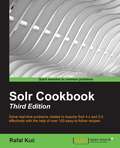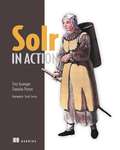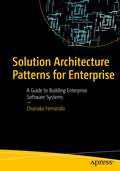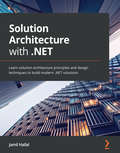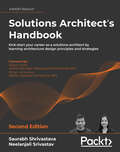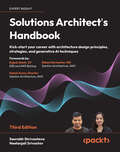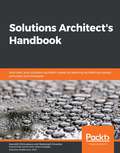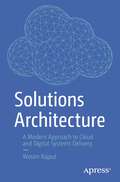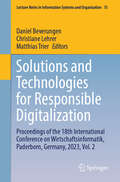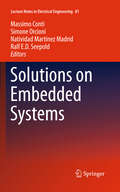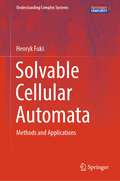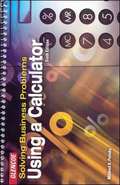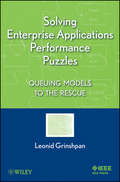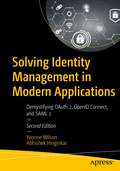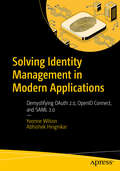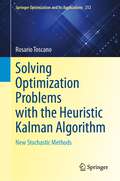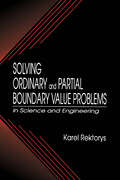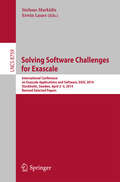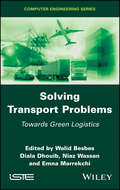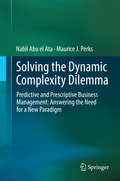- Table View
- List View
Solr Cookbook - Third Edition
by Rafał KućThis book is for intermediate Solr Developers who are willing to learn and implement Pro-level practices, techniques, and solutions. This edition will specifically appeal to developers who wish to quickly get to grips with the changes and new features of Apache Solr 5.
Solr in Action
by Timothy Potter Trey GraingerSummarySolr in Action is a comprehensive guide to implementing scalable search using Apache Solr. This clearly written book walks you through well-documented examples ranging from basic keyword searching to scaling a system for billions of documents and queries. It will give you a deep understanding of how to implement core Solr capabilities.About the BookWhether you're handling big (or small) data, managing documents, or building a website, it is important to be able to quickly search through your content and discover meaning in it. Apache Solr is your tool: a ready-to-deploy, Lucene-based, open source, full-text search engine. Solr can scale across many servers to enable real-time queries and data analytics across billions of documents.Solr in Action teaches you to implement scalable search using Apache Solr. This easy-to-read guide balances conceptual discussions with practical examples to show you how to implement all of Solr's core capabilities. You'll master topics like text analysis, faceted search, hit highlighting, result grouping, query suggestions, multilingual search, advanced geospatial and data operations, and relevancy tuning.This book assumes basic knowledge of Java and standard database technology. No prior knowledge of Solr or Lucene is required.Purchase of the print book includes a free eBook in PDF, Kindle, and ePub formats from Manning Publications.What's InsideHow to scale Solr for big dataRich real-world examplesSolr as a NoSQL data storeAdvanced multilingual, data, and relevancy tricksCoverage of versions through Solr 4.7About the AuthorsTrey Grainger is a director of engineering at CareerBuilder. Timothy Potter is a senior member of the engineering team at LucidWorks. The authors work on the scalability and reliability of Solr, as well as on recommendation engine and big data analytics technologies.Table of ContentsPART 1 MEET SOLRIntroduction to SolrGetting to know Solr Key Solr concepts Configuring Solr Indexing Text analysis PART 2 CORE SOLR CAPABILITIESPerforming queries and handling resultsFaceted searchHit highlightingQuery suggestionsResult grouping/field collapsingTaking Solr to productionPART 3 TAKING SOLR TO THE NEXT LEVELSolrCloudMultilingual searchComplex query operationsMastering relevancy
Solution Architecture Patterns for Enterprise: A Guide to Building Enterprise Software Systems
by Chanaka FernandoGain a deeper understanding of how distributed systems work, as well as which applications and systems are used for specific business domains or industries. This book provides a set of solution architecture patterns that were developed based on the author’s experience building enterprise software systems for hundreds of different organizations across the globe. The architecture diagrams (patterns) and examples allow you to not only grasp the concepts, but to build working projects. Solution Architecture Patterns for Enterprise starts with an introduction to the concepts of enterprise software systems and solution architecture and later moves to individual solution architecture patterns used in real-world enterprises. Subsequent sections cover various industry-specific solution architecture patterns that can be used to build domain-specific software systems. The book concludes with a view of what the future holds for solution architecture, including likely new developments in the field. This book will help enterprise software architects and engineers to design and implement real-world enterprise software systems using best practices and techniques adopted by organizations across the globe. It provides software architecture blueprints to build domain-specific enterprise software systems. If you are working on any digital transformation project or initiative, you will find this book useful, as it provides quick reference on architecture and implementation to get started with your work. What You Will LearnUnderstand the key elements of enterprise software systems and how to design and implement themMaster different approaches to build real-world software applicationsBuild domain specific enterprise software systemsUse open-source tools to build enterprise software systems Who This Book Is For Software Developers, software architect, solution architects, and enterprise architects.
Solution Architecture with .NET: Learn solution architecture principles and design techniques to build modern .NET solutions
by Jamil HallalLearn about the responsibilities of a .NET solution architect and explore solution architecture principles, DevOps solutions, and design techniques and standards with hands-on examples of design patternsKey FeaturesFind out what are the essential personality traits and responsibilities of a solution architectBecome well-versed with architecture principles and modern design patterns with hands-on examplesDesign modern web solutions and make the most of Azure DevOps to automate your development life cycleBook DescriptionUnderstanding solution architecture is a must to build and integrate robust systems to meet your client's needs. This makes it crucial for a professional .NET software engineer to learn the key skills of a .NET solution architect to create a unique digital journey and build solutions for a wide range of industries, from strategy and design to implementation. With this handbook, developers working with the .NET technology will be able to put their knowledge to work.The book takes a hands-on approach to help you become an effective solution architect. You'll start by learning the principles of the software development life cycle (SDLC), the roles and responsibilities of a .NET solution architect, and what makes a great .NET solution architect. As you make progress through the chapters, you'll understand the principles of solution architecture and how to design a solution, and explore designing layers and microservices. You'll complete your learning journey by uncovering modern design patterns and techniques for designing and building digital solutions.By the end of this book, you'll have learned how to architect your modern web solutions with ASP.NET Core and Microsoft Azure and be ready to automate your development life cycle with Azure DevOps.What you will learnUnderstand the role and core responsibilities of a .NET solution architectStudy popular UML (Unified Modeling Language) diagrams for solution architectureWork with modern design patterns with the help of hands-on examplesBecome familiar with microservices and designing layersDiscover how to design modern web solutionsAutomate your development life cycle with Azure DevOpsWho this book is forThis book is for intermediate and advanced .NET developers and software engineers who want to advance their careers and expand their knowledge of solution architecture and design principles. Beginner or intermediate-level solution architects looking for tips and tricks to build large-scale .NET solutions will find this book useful.
Solution and Characteristic Analysis of Fractional-Order Chaotic Systems
by Kehui Sun Shaobo He Huihai WangThis book highlights the solution algorithms and characteristic analysis methods of fractional-order chaotic systems. Fractal dimensions exist broadly in the study of nature and the development of science and technology. Fractional calculus has become a hot research area in nonlinear science. Fractional-order chaotic systems are an important part of fractional calculus. The book discusses the numerical solution algorithms and characteristic analysis of fractional-order chaotic systems and introduces the techniques to implement the systems with circuits. To facilitate a quick grasp, the authors present examples from their years of work in the appendix. Intended for graduate students and researchers interested in chaotic systems, the book helps one to build a theoretical and experimental foundation for the application of fractional-order chaotic systems.
Solutions Architect's Handbook: Kick-start your career as a solutions architect by learning architecture design principles and strategies
by Saurabh Shrivastava Neelanjali SrivastavThird edition out now with coverage on Generative AI, clean architecture, edge computing, and moreKey FeaturesTurn business needs into end-to-end technical architectures with this practical guideAssess and overcome various challenges while updating or modernizing legacy applicationsFuture-proof your architecture with IoT, machine learning, and quantum computingBook DescriptionBecoming a solutions architect requires a hands-on approach, and this edition of the Solutions Architect's Handbook brings exactly that. This handbook will teach you how to create robust, scalable, and fault-tolerant solutions and next-generation architecture designs in a cloud environment. It will also help you build effective product strategies for your business and implement them from start to finish. This new edition features additional chapters on disruptive technologies, such as Internet of Things (IoT), quantum computing, data engineering, and machine learning. It also includes updated discussions on cloud-native architecture, blockchain data storage, and mainframe modernization with public cloud. The Solutions Architect's Handbook provides an understanding of solution architecture and how it fits into an agile enterprise environment. It will take you through the journey of solution architecture design by providing detailed knowledge of design pillars, advanced design patterns, anti-patterns, and the cloud-native aspects of modern software design. By the end of this handbook, you'll have learned the techniques needed to create efficient architecture designs that meet your business requirements.What you will learnExplore the various roles of a solutions architect in the enterprise landscapeImplement key design principles and patterns to build high-performance cost-effective solutionsChoose the best strategies to secure your architectures and increase their availabilityModernize legacy applications with the help of cloud integrationUnderstand how big data processing, machine learning, and IoT fit into modern architectureIntegrate a DevOps mindset to promote collaboration, increase operational efficiency, and streamline productionWho this book is forThis book is for software developers, system engineers, DevOps engineers, architects, and team leaders who already work in the IT industry and aspire to become solutions architect professionals. Existing solutions architects who want to expand their skillset or get a better understanding of new technologies will also learn valuable new skills. To get started, you'll need a good understanding of the real-world software development process and general programming experience in any language.
Solutions Architect's Handbook: Kick-start your career as a solutions architect by learning architecture design principles and strategies, 2nd Edition
by Kamal Arora Saurabh Shrivastava Neelanjali Srivastav Rajesh Sheth Rohan KarmarkarFrom fundamentals and design patterns to the different strategies for creating secure and reliable architectures in AWS cloud, learn everything you need to become a successful solutions architect.Purchase of the print or Kindle book includes a free eBook in the PDF format.Endorsements"For new or existing solutions architects looking to keep their skills sharp in the cloud era, this book hits all the key areas."-Rajesh Sheth, GM, Messaging and Streaming, AWS"...the go-to guide for understanding various functions in the age of cloud computing."-Rohan Karmarkar, Director, Solutions Architecture, AWS"...you will find very important nuggets of knowledge that will help you be a successful solutions architect, and open up a new world of infinite possibilities!"-Kamal Arora, Senior Manager, Solutions Architecture, AWSBook DescriptionBecoming a solutions architect requires a hands-on approach, and this edition of the Solutions Architect's Handbook brings exactly that. This handbook will teach you how to create robust, scalable, and fault-tolerant solutions and next-generation architecture designs in a cloud environment. It will also help you build effective product strategies for your business and implement them from start to finish.This new edition features additional chapters on disruptive technologies, such as Internet of Things (IoT), quantum computing, data engineering, and machine learning. It also includes updated discussions on cloud-native architecture, blockchain data storage, and mainframe modernization with public cloud.The Solutions Architect's Handbook provides an understanding of solution architecture and how it fits into an agile enterprise environment. It will take you through the journey of solution architecture design by providing detailed knowledge of design pillars, advanced design patterns, anti-patterns, and the cloud-native aspects of modern software design.By the end of this handbook, you'll have learned the techniques needed to create efficient architecture designs that meet your business requirements.What you will learnExplore the various roles of a solutions architect in the enterprise landscapeImplement key design principles and patterns to build high-performance cost-effective solutionsChoose the best strategies to secure your architectures and increase their availabilityModernize legacy applications with the help of cloud integrationUnderstand how big data processing, machine learning, and IoT fit into modern architectureIntegrate a DevOps mindset to promote collaboration, increase operational efficiency, and streamline productionWho this book is forThis book is for software developers, system engineers, DevOps engineers, architects, and team leaders who already work in the IT industry and aspire to become solutions architect professionals.Existing solutions architects who want to expand their skillset or get a better understanding of new technologies will also learn valuable new skills.To get started, you'll need a good understanding of the real-world software development process and general programming experience in any language.
Solutions Architect's Handbook: Kick-start your career with architecture design principles, strategies, and generative AI techniques
by Saurabh Shrivastava Neelanjali SrivastavFrom fundamentals and design patterns to the latest techniques such as generative AI, machine learning and cloud native architecture, gain all you need to be a pro Solutions Architect crafting secure and reliable AWS architecture.Key FeaturesHits all the key areas -Rajesh Sheth, VP, Elastic Block Store, AWSOffers the knowledge you need to succeed in the evolving landscape of tech architecture - Luis Lopez Soria, Senior Specialist Solutions Architect, GoogleA valuable resource for enterprise strategists looking to build resilient applications - Cher Simon, Principal Solutions Architect, AWSBook DescriptionBuild a strong foundation in solution architecture and excel in your career with the Solutions Architect’s Handbook. Authored by seasoned AWS technology leaders Saurabh Shrivastav and Neelanjali Srivastav, this book goes beyond traditional certification guides, offering in-depth insights and advanced techniques to meet the specific needs and challenges of solutions architects today. This edition introduces exciting new features that keep you at the forefront of this evolving field. From large language models and generative AI to deep learning innovations, these cutting-edge advancements are shaping the future of technology. Key topics such as cloud-native architecture, data engineering architecture, cloud optimization, mainframe modernization, and building cost-efficient, secure architectures remain essential today. This book covers both emerging and foundational technologies, guiding you through solution architecture design with key principles and providing the knowledge you need to succeed as a Solutions Architect. It also sharpens your soft skills, providing career-accelerating techniques to stay ahead. By the end of this book, you will be able to harness cutting-edge technologies, apply practical insights from real-world scenarios, and enhance your solution architecture skills with the Solutions Architect's Handbook.What you will learnExplore various roles of a solutions architect in the enterpriseApply design principles for high-performance, cost-effective solutionsChoose the best strategies to secure your architectures and boost availabilityDevelop a DevOps and CloudOps mindset for collaboration, operational efficiency, and streamlined productionApply machine learning, data engineering, LLMs, and generative AI for improved security and performanceModernize legacy systems into cloud-native architectures with proven real-world strategiesMaster key solutions architect soft skillsWho this book is forThis book is for software developers, system engineers, DevOps engineers, architects, and team leaders who already work in the IT industry and aspire to become solutions architect professionals. Solutions architects who want to expand their skillset or get a better understanding of new technologies will also learn valuable new skills. To get started, you'll need a good understanding of the real-world software development process and some awareness of cloud technology.
Solutions Architect's Handbook: Kick-start your solutions architect career by learning architecture design principles and strategies
by Kamal Arora Saurabh Shrivastava Neelanjali SrivastavFrom fundamentals and design patterns to the different strategies for creating secure and reliable architectures in AWS cloud, learn everything you need to become a successful solutions architect Key Features Create solutions and transform business requirements into technical architecture with this practical guide Understand various challenges that you might come across while refactoring or modernizing legacy applications Delve into security automation, DevOps, and validation of solution architecture Book Description Becoming a solutions architect gives you the flexibility to work with cutting-edge technologies and define product strategies. This handbook takes you through the essential concepts, design principles and patterns, architectural considerations, and all the latest technology that you need to know to become a successful solutions architect. This book starts with a quick introduction to the fundamentals of solution architecture design principles and attributes that will assist you in understanding how solution architecture benefits software projects across enterprises. You'll learn what a cloud migration and application modernization framework looks like, and will use microservices, event-driven, cache-based, and serverless patterns to design robust architectures. You'll then explore the main pillars of architecture design, including performance, scalability, cost optimization, security, operational excellence, and DevOps. Additionally, you'll also learn advanced concepts relating to big data, machine learning, and the Internet of Things (IoT). Finally, you'll get to grips with the documentation of architecture design and the soft skills that are necessary to become a better solutions architect. By the end of this book, you'll have learned techniques to create an efficient architecture design that meets your business requirements. What you will learn Explore the various roles of a solutions architect and their involvement in the enterprise landscape Approach big data processing, machine learning, and IoT from an architect's perspective and understand how they fit into modern architecture Discover different solution architecture patterns such as event-driven and microservice patterns Find ways to keep yourself updated with new technologies and enhance your skills Modernize legacy applications with the help of cloud integration Get to grips with choosing an appropriate strategy to reduce cost Who this book is for This book is for software developers, system engineers, DevOps engineers, architects, and team leaders working in the information technology industry who aspire to become solutions architect professionals. A good understanding of the software development process and general programming experience with any language will be useful.
Solutions Architecture: A Modern Approach to Cloud and Digital Systems Delivery
by Wasim RajputExplore the complex world of digital solutions architecture and its pivotal role in the modern, technology-driven organization. The book provides a detailed roadmap, charting the intricate processes that solutions architects undertake to transform high-level business propositions into practical, actionable digital solutions. Offering a number of real-world examples, you'll work through examples of various digital projects encompassing cutting-edge technologies such as AI/ML, IoT, Cloud, and the integration with legacy systems. The book also explains how various elements coalesce to form a resilient solutions architecture, shedding light on the need for collaborative synergy between different organizational stakeholders, teams and disciplines. Solutions Architecture underscores the significance of aligning business and technology, demonstrating how this strategic collaboration maximizes the success of digital projects, setting you on the path to a more robust and successful digital future for your organization.What You Will LearnUnderstand the solutions architecture process, including key concepts and best practicesIdentify business needs and requirements and translate them into actionable steps that result in effective digital solutionsSelect appropriate technologies, build prototypes, and conduct testing and validationDesign, implement, and maintain solutions Who This Book Is ForDigital Transformation Program Management, Program Managers, Solutions Architects, IT/Digital Project Managers
Solutions and Technologies for Responsible Digitalization: Proceedings of the 18th International Conference on Wirtschaftsinformatik, Paderborn, Germany, 2023, Vol. 2 (Lecture Notes in Information Systems and Organisation #75)
by Daniel Beverungen Christiane Lehrer Matthias TrierThis book is the second volume of proceedings from the 18th International Conference on Wirtschaftsinformatik held in Paderborn, Germany, in 2023. In the context of the global trend toward digitalization, it presents the results of innovative, high-quality research in the field of information systems and digital transformation. The book covers a broad range of topics, including digital innovation, business analytics, artificial intelligence, and IT strategy, each of which has and will continue to have significant impacts on companies, individuals and societies alike.
Solutions on Embedded Systems
by Simone Orcioni Natividad Martínez Madrid Massimo Conti Ralf E.D. SeepoldEmbedded systems have an increasing importance in our everyday lives. The growing complexity of embedded systems and the emerging trend to interconnections between them lead to new challenges. Intelligent solutions are necessary to overcome these challenges and to provide reliable and secure systems to the customer under a strict time and financial budget. Solutions on Embedded Systems documents results of several innovative approaches that provide intelligent solutions in embedded systems. The objective is to present mature approaches, to provide detailed information on the implementation and to discuss the results obtained.
Solutions on Embedded Systems (Lecture Notes in Electrical Engineering #81)
by Simone Orcioni Natividad Martínez Madrid Massimo Conti Ralf E.D. SeepoldEmbedded systems have an increasing importance in our everyday lives. The growing complexity of embedded systems and the emerging trend to interconnections between them lead to new challenges. Intelligent solutions are necessary to overcome these challenges and to provide reliable and secure systems to the customer under a strict time and financial budget.Solutions on Embedded Systems documents results of several innovative approaches that provide intelligent solutions in embedded systems. The objective is to present mature approaches, to provide detailed information on the implementation and to discuss the results obtained.
Solvable Cellular Automata: Methods and Applications (Understanding Complex Systems)
by Henryk FukśThe main focus of the book is solvability of cellular automata, that is, expressing the state of a given cell after a given number of steps by an explicit formula. The author considers solutions of two types of initial value problems for cellular automata, the deterministic one and the probabilistic one. In the first chapter the basic concepts of cellular automata theory are introduced. Deterministic initial value problem is introduced next and solutions for selected simple rules are also presented. In the following chapters various techniques for solving the deterministic problem are introduced, using elementary CA rules of increasing complexity as examples. The second part of the book introduces the concept of probability measure in the context of cellular automata and the probabilistic initial value problem for both deterministic and probabilistic rules. The book is amply illustrated with examples and applications such as the density classification problem, phase transitions in traffic models or the diffusion of innovations model. In the appendix, solution formulae (both deterministic and probabilistic) for over 60 elementary cellular automata rules are listed. Ruelle-Frobenius-Perron equations for all 88 minimal elementary cellular automata are also provided.
Solving Business Problems Using a Calculator (Sixth Edition)
by Mildred K. PoliskySolving Business Problems Using a Calculator follows current trends in office technology, teaches the touch method, explains common calculator features, and emphasizes business problem solving. In the sixth edition, the text's popular features have been maintained along with its concise explanations and emphasis on the use of the calculator as a problem-solving tool.
Solving Differential Equations in R
by Francesca Mazzia Jeff Cash Karline SoetaertMathematics plays an important role in many scientific and engineering disciplines. This book deals with the numerical solution of differential equations, a very important branch of mathematics. Our aim is to give a practical and theoretical account of how to solve a large variety of differential equations, comprising ordinary differential equations, initial value problems and boundary value problems, differential algebraic equations, partial differential equations and delay differential equations. The solution of differential equations using R is the main focus of this book. It is therefore intended for the practitioner, the student and the scientist, who wants to know how to use R for solving differential equations. However, it has been our goal that non-mathematicians should at least understand the basics of the methods, while obtaining entrance into the relevant literature that provides more mathematical background. Therefore, each chapter that deals with R examples is preceded by a chapter where the theory behind the numerical methods being used is introduced. In the sections that deal with the use of R for solving differential equations, we have taken examples from a variety of disciplines, including biology, chemistry, physics, pharmacokinetics. Many examples are well-known test examples, used frequently in the field of numerical analysis.
Solving Enterprise Applications Performance Puzzles
by Leonid GrinshpanPoorly performing enterprise applications are the weakest links in a corporation's management chain, causing delays and disruptions of critical business functions. This groundbreaking book frames enterprise application performance engineering not as an art but as applied science built on model-based methodological foundation. The book introduces queuing models of enterprise application that visualize, demystify, explain, and solve system performance issues. Analysis of these models will help to discover and clarify unapparent connections and correlations among workloads, hardware architecture, and software parameters.
Solving Halal Industry Issues Through Research in Halal Sciences
by Azura Amid Amal A. M. Elgharbawy Walaa A. AbualsununThis book serves as a platform for the global community of halal researchers to share their insights on approaches to solve halal industry issues through science. The global halal industry is estimated to be worth around USD2.3 trillion (excluding Islamic finance). Growing at an estimated annual rate of 20%, the industry is valued at about USD560 billion a year, making it one of the fastest-growing consumer segments in the world. The global halal market of 1.8 billion Muslims is no longer confined to food and food-related products. This book brings together research carried out through halal sciences to solve issues in halal industries, covering topics such as general issues in halal industries, the level of verification and authentication, finding alternative materials or ingredients that are halal in pharmaceutical and food industries, as well as legal issues that could arise. This book is useful to graduate students in universities, researchers, academics, and industry practitioners working in halal industries.
Solving Identity Management in Modern Applications: Demystifying OAuth 2, OpenID Connect, and SAML 2
by Yvonne Wilson Abhishek HingnikarKnow how to design and use identity management to protect your application and the data it manages.At a time when security breaches result in increasingly onerous penalties, it is paramount that application developers and owners understand identity management and the value it provides when building applications. This book takes you from account provisioning to authentication to authorization, and covers troubleshooting and common problems to avoid. The authors include predictions about why this will be even more important in the future. Application best practices with coding samples are provided.Solving Identity and Access Management in Modern Applications gives you what you need to design identity and access management for your applications and to describe it to stakeholders with confidence. You will be able to explain account creation, session and access management, account termination, and more.This expanded edition has been revised to provide an overview of the new version of OAuth (2.1)―the primary changes in this version, including features that were removed from 2.1 that were in 2.0 and why they were removed. The discussion of the book's accompanying sample application has been revised to cover in more depth the approach for developing the application (also revised). A new section has been added on the OAuth 2.0 Device Authorization Grant (RFC 8628) specification, which is useful for devices with limited UI capability. Minor additions include the topics of identity proofing, the need to capture and organize consent information, the impact of tracking prevention technology on certain identity protocols, and the availability of additional options for authorization requests such as OAuth 2.0 Rich Authorization Requests and JWT-Secured Authorization Requests (RFC 9101).What You’ll Learn• Understand key identity management concepts• Incorporate essential design principles• Design authentication and access control for a modern application• Know the identity management frameworks and protocols used today (OIDC/OAuth 2.0/2.1, SAML 2.0)• Review historical failures and know how to avoid themWho This Book Is ForDevelopers, enterprise or application architects, business application or product owners, and anyone involved in an application's identity management solution
Solving Identity Management in Modern Applications: Demystifying OAuth 2.0, OpenID Connect, and SAML 2.0
by Yvonne Wilson Abhishek HingnikarKnow how to design and use identity management to protect your application and the data it manages.At a time when security breaches result in increasingly onerous penalties, it is paramount that application developers and owners understand identity management and the value it provides when building applications. This book takes you from account provisioning to authentication to authorization, and covers troubleshooting and common problems to avoid. The authors include predictions about why this will be even more important in the future. Application best practices with coding samples are provided.Solving Identity and Access Management in Modern Applications gives you what you need to design identity and access management for your applications and to describe it to stakeholders with confidence. You will be able to explain account creation, session and access management, account termination, and more. What You’ll Learn Understand key identity management conceptsIncorporate essential design principlesDesign authentication and access control for a modern applicationKnow the identity management frameworks and protocols used today (OIDC/ OAuth 2.0, SAML 2.0)Review historical failures and know how to avoid them Who This Book Is For Developers, enterprise or application architects, business application or product owners, and anyone involved in an application's identity management solution
Solving Optimization Problems with the Heuristic Kalman Algorithm: New Stochastic Methods (Springer Optimization and Its Applications #212)
by Rosario ToscanoThis text focuses on simple and easy-to-use design strategies for solving complex engineering problems that arise in several fields of engineering design, namely non-convex optimization problems. The main optimization tool used in this book to tackle the problem of nonconvexity is the Heuristic Kalman Algorithm (HKA). The main characteristic of HKA is the use of a stochastic search mechanism to solve a given optimization problem. From a computational point of view, the use of a stochastic search procedure appears essential for dealing with non-convex problems.The topics discussed in this monograph include basic definitions and concepts from the classical optimization theory, the notion of the acceptable solution, machine learning, the concept of preventive maintenance, and more. The Heuristic Kalman Algorithm discussed in this book applies to many fields such as robust structured control, electrical engineering, mechanical engineering, machine learning, reliability, and preference models. This large coverage of practical optimization problems makes this text very useful to those working on and researching systems design. The intended audience includes industrial engineers, postgraduates, and final-year undergraduates in various fields of systems design.
Solving Ordinary and Partial Boundary Value Problems in Science and Engineering (Applied and Computational Mechanics)
by Karel RektorysThis book provides an elementary, accessible introduction for engineers and scientists to the concepts of ordinary and partial boundary value problems, acquainting readers with fundamental properties and with efficient methods of constructing solutions or satisfactory approximations.Discussions include: ordinary differential equations classical theory of partial differential equations Laplace and Poisson equations heat equation variational methods of solution of corresponding boundary value problems methods of solution for evolution partial differential equations The author presents special remarks for the mathematical reader, demonstrating the possibility of generalizations of obtained results and showing connections between them. For the non-mathematician, the author provides profound functional-analytical results without proofs and refers the reader to the literature when necessary.Solving Ordinary and Partial Boundary Value Problems in Science and Engineering contains essential functional analytical concepts, explaining its subject without excessive abstraction.
Solving Software Challenges for Exascale
by Stefano Markidis Erwin LaureThis volume contains the thoroughly refereed post-conference proceedings of the Second International Conference on Exascale Applications and Software, EASC 2014, held in Stockholm, Sweden, in April 2014. The 6 full papers presented together with 6 short papers were carefully reviewed and selected from 17 submissions. They are organized in two topical sections named: toward exascale scientific applications and development environment for exascale applications.
Solving Transport Problems: Towards Green Logistics
by Walid Besbes Diala Dhouib Niaz Wassan Emna MarrekchiSolving Transport Problems establishes fundamental points and good practice in resolving matters regarding green transportation. This is to prompt further research in conveyance issues by providing readers with new knowledge and grounds for integrated models and solution methods. Focusing on green transportation, this book covers various sub-topics and thus consists of diverse content. Traditionally, academia and transport practitioners have mainly concentrated on efficient fleet management to achieve economic benefits and better-quality service. More recently, due to growing public environmental concerns and the industry understanding of the issue, the academic community has started to address environmental issues. The studies of green transportation compiled in this book have identified certain areas of interest, such as references, viewpoints, algorithms and ideas. Solving Transport Problems is for researchers, environmental decision-makers and other concerned parties, to start discussion on developing optimized technology and alternative fuel-based integrated models for environmentally cleaner transport systems.
Solving the Dynamic Complexity Dilemma
by Nabil Abu el Ata Maurice J. PerksDynamic complexity results from hidden, unknown factors--or more precisely, interactions between factors--that can unexpectedly impact the performance of systems. When the influences of dynamic complexity are not measured and understood, new never-seen-before behaviors can come as unwelcomed surprises, which disrupt the performance of systems. Left alone, processes that were once prized for their efficiency unexpectedly begin to degrade--costs increase, while volumes and quality decline. Evidence of problems may come too late for effective resolution as technology advancements induce rapid change and compress the time available to react to that change. The results of dynamic complexity are always negative and unmanaged dynamic complexity can bring business or global systems to the point of sudden chaos. The 2009 H1N1 pandemic, 2008 Credit Crunch and 2011 Fukushima Daiichi nuclear disaster are global examples of the dangers of undiagnosed dynamic complexity. With increasing frequency executive leaders today are discovering that their business and IT system performance levels are not meeting expectations. In most cases these performance deficiencies are caused by dynamic complexity, which lies hidden like a cancer until the symptoms reveal themselves--often when it is too late to avoid negative impacts on business outcomes. This book examines the growing business problem of dynamic complexity and presents a path to a practical solution. To achieve better predictability, organizations must be able to expose new, dangerous patterns of behavior in time to take corrective actions and know which actions will yield the optimal results. The book authors promote new methods of risk management that use data collection, analytics, machine learning and automation processes to help organizations more accurately predict the future and take strategic actions to improve performance outcomes. The presented means of achieving this goal are based upon the authors' practical experiences, backed by scientific principles, and results achieved through consulting engagements with over 350 global organizations.
